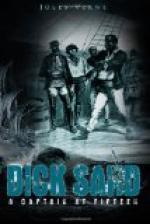* * * * *
CHAPTER IX.
KAZOUNDE.
ON May 26th, the caravan of slaves arrived at Kazounde. Fifty per cent. of the prisoners taken in the last raid had fallen on the road. Meanwhile, the business was still good for the traders; demands were coming in, and the price of slaves was about to rise in the African markets.
Angola at this period did an immense trade in blacks. The Portuguese authorities of St. Paul de Loanda, or of Benguela, could not stop it without difficulty, for the convoys traveled towards the interior of the African continent. The pens near the coast overflowed with prisoners, the few slavers that succeeded in eluding the cruisers along the shore not being sufficient to carry all of them to the Spanish colonies of America.
Kazounde, situated three hundred miles from the mouth of the Coanza, is one of the principal “lakonis,” one of the most important markets of the province. On its grand square the “tchitoka” business is transacted; there, the slaves are exposed and sold. It is from this point that the caravans radiate toward the region of the great lakes.
Kazounde, like all the large towns of Central Africa, is divided into two distinct parts. One is the quarter of the Arab, Portuguese or native traders, and it contains their pens; the other is the residence of the negro king, some ferocious crowned drunkard, who reigns through terror, and lives from supplies furnished by the contractors.
At Kazounde, the commercial quarter then belonged to that Jose-Antonio Alvez, of whom Harris and Negoro had spoken, they being simply agents in his pay. This contractor’s principal establishment was there, he had a second at Bihe, and a third at Cassange, in Benguela, which Lieutenant Cameron visited some years later.
Imagine a large central street, on each side groups of houses, “tembes,” with flat roofs, walls of baked earth, and a square court which served as an enclosure for cattle. At the end of the street was the vast “tchitoka” surrounded by slave-pens. Above this collection of buildings rose some enormous banyans, whose branches swayed with graceful movements. Here and there great palms, with their heads in the air, drove the dust on the streets like brooms. Twenty birds of prey watched over the public health. Such is the business quarter of Kazounde.
Near by ran the Louhi, a river whose course, still undetermined, is an affluent, or at least a sub-affluent, of the Coango, a tributary of the Zoire.




